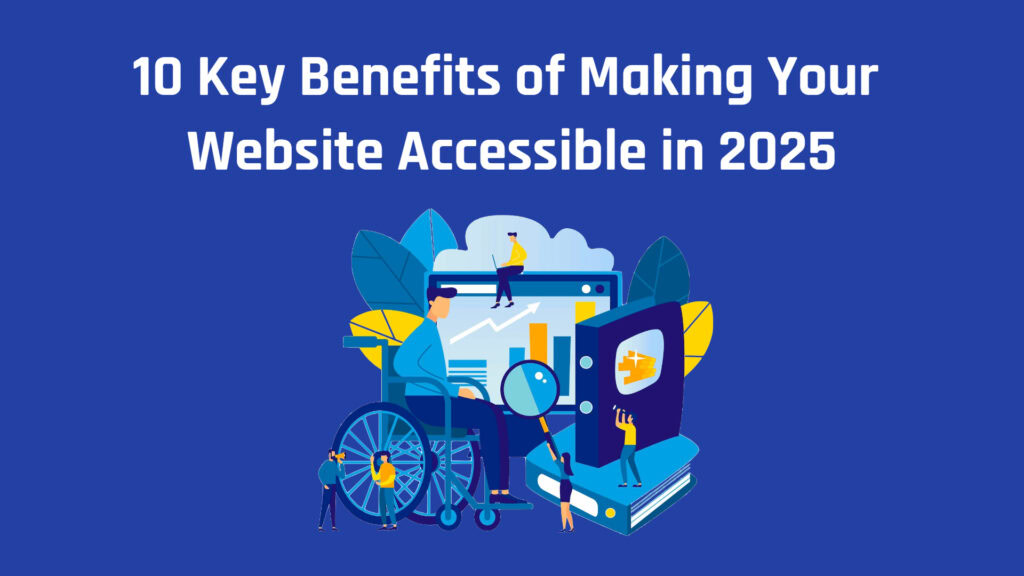Why Accessibility Matters in 2025
As we progress further into 2025, the importance of web accessibility cannot be overstated. With the rapid increase in digital engagement, particularly among individuals with disabilities, businesses are faced with an imperative to ensure their online platforms are accessible to all users. The change in demographics and the constant advancements in technology call for a reevaluation of how we perceive and implement website accessibility.
Accessibility in 2025 is primarily driven by the growing number of people who rely on the internet for everyday tasks, such as shopping, banking, and social interaction. According to recent statistics, over one billion people worldwide live with some form of disability, which includes visual, auditory, motor, and cognitive impairments. Thus, it is essential for organizations to acknowledge and accommodate this significant segment of the population in their digital strategies. Failure to do so not only excludes a large group of potential customers but also disregards their rights to access information and services equally.
Moreover, web accessibility is more than just a best practice; it is a legal requirement under the Americans with Disabilities Act (ADA) and similar regulations globally. Compliance with these laws is not only necessary to avoid potential lawsuits but also reflects a company’s commitment to inclusivity and social responsibility. In 2025, businesses that overlook accessibility risks alienating a substantial customer base and may face reputational damage as consumers increasingly prioritize ethical practices. Ensuring that websites are navigable and usable for everyone is essential for fostering a more inclusive environment in the digital realm.
As we adapt to an increasingly digital society, the drive toward accessibility must remain steadfast. The moral imperative to create inclusive spaces for all users is becoming not just preferable but essential for sustained business success in today’s interconnected world.
The Growing Importance of ADA Compliance
The Americans with Disabilities Act (ADA) was enacted to ensure individuals with disabilities have equal access to all aspects of public life, including the digital realm. In recent years, there has been a substantial increase in the number of lawsuits related to ADA compliance, particularly concerning websites. As more consumers become aware of their rights, the legal landscape has transformed, placing heightened scrutiny on businesses that fail to meet accessibility standards. A notable trend is that plaintiffs are no longer just individuals with disabilities; advocacy groups and organizations are increasingly active in pursuing legal action against companies that neglect their obligations under the ADA.
Legal consequences for non-compliance can be severe. Companies may face costly settlements, legal fees, and reputational damage that can erode customer trust. For example, in 2022 alone, thousands of ADA-related lawsuits were filed, spotlighting the urgency for businesses to review their digital accessibility policies. Organizations that do not prioritize ADA compliance risk being targeted by litigation that not only affects their financial bottom line but also their brand image. As consumer awareness around disability rights continues to grow, businesses must acknowledge their responsibility in creating an inclusive online environment.
Furthermore, government agencies and regulatory bodies are increasingly promoting the enforcement of ADA compliance by issuing guidelines and advocating for better practices. This is leading businesses to not only recognize the legal implications of their websites’ accessibility but also understand the moral responsibility they hold. By making proactive adjustments and ensuring compliance with accessibility standards, organizations can mitigate risks associated with legal action and demonstrate their commitment to inclusivity. The growing importance of ADA compliance serves as a critical reminder that a website’s accessibility is not just a legal necessity; it is fundamental to fostering an equitable digital experience for all individuals, regardless of their abilities.

Accessibility as a Business Imperative
In today’s digital landscape, website accessibility has emerged as a crucial component of an organization’s strategic framework. As businesses increasingly move towards a customer-centric approach, ensuring that websites are accessible to all users, including those with disabilities, transcends mere regulatory compliance. Rather, it should be recognized as an essential business imperative that can drive both growth and innovation.
An accessible website effectively broadens market reach, enabling businesses to tap into a larger demographic. According to statistics from the World Health Organization, approximately 1 billion people live with some form of disability. By creating an inclusive online experience, organizations not only cater to this significant audience but also enhance user satisfaction for all customers, whether they face disabilities or not. A website that is intuitive and easy to navigate fosters a positive user experience, leading to increased customer loyalty and repeat visits.
Furthermore, prioritizing accessibility can yield substantial financial benefits. Research shows that companies that embrace inclusion and diversity often outperform their competitors. By aligning their digital presence with accessibility standards, businesses not only avoid potential penalties related to non-compliance but also position themselves favorably in the eyes of consumers who value social responsibility. The modern consumer increasingly prefers brands that demonstrate a commitment to inclusivity, which can boost brand reputation and drive revenue growth.
In conclusion, considering accessibility as a core aspect of business strategy can produce far-reaching benefits. It acts as a catalyst for expanding market opportunities and enhancing customer satisfaction, ultimately resulting in a more robust bottom line. By investing in an accessible website, businesses position themselves not just as compliant entities, but as forward-thinking organizations committed to fostering an inclusive digital environment.
Top Benefits of Accessible Websites
Creating an accessible website offers numerous advantages across various dimensions, making it a critical undertaking for organizations in 2025. One of the primary benefits of an accessible website is its potential to enhance search engine optimization (SEO). Search engines favor well-structured, accessible content, which can lead to higher rankings in search results. This is due to the practice of implementing semantic HTML, providing alt text for images, and ensuring that the website is navigable via keyboard. Consequently, these practices not only aid individuals with disabilities but also improve the website’s visibility to all potential users.
Another significant benefit is the overall user engagement. An accessible website is designed to cater to a diverse audience, enabling users with varying abilities to interact effortlessly with the content. This inclusivity fosters a positive user experience, which in turn can lead to increased time spent on the page and a lower bounce rate. Engaging a broader audience ultimately translates into higher conversion rates, making accessibility a valuable investment for businesses aiming to boost their online presence.
From an operational standpoint, creating accessible websites minimizes legal risks. Countries and regions increasingly enforce regulations mandating digital accessibility, such as the Americans with Disabilities Act (ADA) in the United States and the Web Content Accessibility Guidelines (WCAG) worldwide. By prioritizing accessibility, organizations can mitigate potential lawsuits and the associated costs, thereby safeguarding their reputations and resources.
Finally, enhancing the accessibility of your website contributes to a competitive advantage. Organizations that embrace inclusivity are often viewed more favorably by consumers. This perception can lead to increased brand loyalty and customer retention, positioning businesses as leaders in corporate social responsibility. As more users recognize the importance of an accessible web, companies can differentiate themselves by prioritizing inclusivity in their digital strategies.

1. Boosted SEO Performance
Ensuring that a website is accessible is not only a matter of inclusivity but also a significant contributor to its Search Engine Optimization (SEO) performance. According to data from SEMrush, implementing accessibility practices can markedly enhance the visibility of a website in search engine results. Key practices include the use of descriptive alt text for images, which helps search engines interpret content more effectively. This practice is particularly important, as search engines rely on alt attributes to understand the context of non-text content.
Moreover, utilizing semantic HTML is another crucial component of an accessible website. Semantic HTML involves using proper HTML tags that convey the role and structure of the content. This not only improves usability for individuals with disabilities but also aids search engine crawlers in understanding the hierarchy and importance of information on a page, thereby enhancing SEO outcomes. Websites that adopt semantic markup can see improved indexation and ranking, as search engines reward well-structured and informative content.
Additionally, providing transcripts for multimedia content such as videos and podcasts significantly contributes to accessibility. Transcripts allow search engines to access and index the spoken content, which may otherwise be invisible to crawlers. This added layer of content enriches the overall textual material available on the page, further boosting SEO performance.
In essence, optimizing your website for accessibility serves a dual purpose: it fosters inclusivity and catalyzes enhanced visibility across search engines. By focusing on practices such as alt text usage and semantic HTML, website owners can not only comply with accessibility standards but also embrace a robust strategy for improved search engine rankings, ultimately driving more organic traffic to their platforms.
2. Wider Audience Reach
Creating an accessible website is not merely a legal requirement but a strategic decision that significantly broadens audience reach. In the United States alone, over 61 million individuals live with some form of disability, representing a substantial segment of the population that can benefit from a more inclusive online experience. Accessibility ensures that these individuals can navigate, understand, and engage with website content, fostering a sense of belonging and equal opportunity in the digital realm.
Moreover, inclusive design practices extend far beyond traditional definitions of disability. Seniors, for example, often face challenges related to vision, hearing, and cognition, making it essential to develop user-friendly interfaces that cater to their unique needs. Accommodating a wider audience through accessibility features not only meets the requirements of those with disabilities but also enhances usability for all users, including those who may experience temporary impairments.
Additionally, users in rural areas may encounter limitations in technology or connection reliability, making it vital for websites to load efficiently, be easy to navigate, and provide a clear layout. Accessible websites typically embrace responsive design principles, ensuring optimal performance across various devices and connection speeds. This aspect becomes particularly relevant as mobile device usage continues to rise, with a diverse demographic accessing the internet from various locations.
Ultimately, making a website accessible creates an environment that values diversity and inclusivity. By welcoming individuals with disabilities, seniors, and users in rural regions, businesses and organizations can expand their potential customer base significantly. Not only does this move align with ethical considerations, but it also drives traffic and engagement, ultimately leading to increased conversions and brand loyalty. The commitment to accessibility is a commitment to better service and broader reach, benefitting both audiences and providers alike.
3. Faster Page Load Times
In the fast-evolving digital landscape, the importance of faster page load times cannot be overstated. Accessibility practices inherently contribute to improved site performance by promoting optimized code and streamlined layouts. When websites are designed with accessibility in mind, developers are encouraged to use cleaner, more efficient code. This reduced complexity can significantly enhance the speed at which a webpage loads, providing a better experience for all users, regardless of their capabilities.
Moreover, a decluttered layout is another critical factor in achieving faster load times. By minimizing unnecessary elements and prioritizing essential content, accessible designs can effectively reduce the amount of data that needs to be loaded when users navigate to a webpage. This intentional simplification not only benefits individuals using assistive technologies but also enhances the overall user experience. Fast-loading pages improve user satisfaction and increase the likelihood of visitor retention, making it a win-win for website creators and users alike.
Additionally, accelerated page load times correlate directly with improved Search Engine Optimization (SEO) rankings. Search engines, such as Google, consider load speed as a crucial metric when determining the usability and quality of a website. Therefore, as web developers implement accessible design principles that enhance load speed, they concurrently boost their site’s visibility within search engine results. This underscores the multifaceted benefits of creating an accessible website: higher SEO rankings and a seamless, engaging user experience for all, particularly for those who depend on assistive technologies for navigation. In conclusion, the technical advantages of accessible design extend beyond compliance; they foster an environment conducive to higher performance metrics that ultimately benefit both site owners and users.

4. Enhanced User Experience (UX)
Creating an accessible website significantly enhances the user experience (UX) for all visitors. Accessible design principles ensure that individuals, regardless of their abilities or disabilities, can navigate easily and efficiently. This includes implementing better navigation structures that cater to diverse user needs. By employing clear and logical menu layouts, as well as straightforward pathways to find information, web developers can minimize the cognitive load on users, allowing them to spend more time engaging with the content rather than struggling to access it.
Moreover, adopting keyboard-friendly designs is a crucial aspect of accessibility that positively influences UX. Many users rely on keyboard navigation rather than traditional mouse input, and making web pages responsive to keyboard commands can significantly streamline the interaction process. Implementing features such as tab-based navigation and ensuring that all interactive elements are keyboard accessible can lead to a pleasurable browsing experience for individuals with mobility impairments. This approach not only aids those with disabilities but also benefits general users who appreciate the efficiency of keyboard shortcuts.
In addition to improved navigation and keyboard-friendly features, clearer headings and well-structured content contribute to a better user experience. When information is organized effectively, users can quickly identify relevant sections, facilitating smoother transitions throughout the website. Employing headings that are descriptive and consistent helps users, including those using assistive technologies, to understand the context and flow of the content. This method supports skimming and scanning habits that many users prefer, making it easier for everyone to find pertinent information.
As a result of enhancing user experience through accessible design, websites may see reduced bounce rates as users are more likely to stay and explore the content. This increased engagement translates into higher satisfaction levels and encourages return visits, ultimately benefiting both users and webmasters alike. By prioritizing accessibility, organizations can create a more inclusive and enjoyable online environment for all.
5. Improved Mobile Experience
In the rapidly evolving digital landscape, optimizing for mobile experience has become increasingly critical, especially in light of Google’s mobile-first indexing policy. This approach prioritizes mobile versions of websites for indexing and ranking purposes, reinforcing the necessity of integrating accessible design elements that benefit all users. Accessibility in web design not only aids individuals with disabilities but also enhances the overall mobile usability for a broader audience.
When sites are designed with accessibility features, such as responsive layouts, readable text, and navigable interfaces, they inherently become more user-friendly across various devices. For instance, a well-structured mobile website can significantly improve usability for users with cognitive impairments, who may find it challenging to interact with overly complicated interfaces. By simplifying navigation and ensuring content is easily consumable, website owners can enhance the experience for these users while simultaneously benefiting general audiences.
Furthermore, compliant accessibility practices—such as implementing alt text for images, ensuring sufficient color contrast, and providing keyboard navigability—result in websites that perform better on mobile devices. These practices not only facilitate engagement for users with assistive technologies but also lead to higher retention rates among all visitors. Enhanced mobile experience thus contributes to improved conversion rates, as users are more likely to stay engaged with content that is readily accessible.
As mobile browsing continues to dominate internet usage, adopting accessible web design becomes a foundational step toward meeting not only legal obligations but market expectations. By adhering to mobile accessibility standards, businesses can create an inclusive, efficient browsing environment that accommodates the diverse user base of 2025 and beyond, ensuring that all individuals, regardless of ability, can interact with their content effectively.
6. Legal Compliance and Risk Mitigation
Adhering to the Americans with Disabilities Act (ADA) and the Web Content Accessibility Guidelines (WCAG) is vital for businesses seeking to protect themselves from potential legal repercussions. In 2025, as the landscape of website accessibility evolves, the importance of compliance with these regulations will only increase. A significant number of lawsuits regarding website accessibility have been filed in recent years, and businesses that fail to ensure their websites are user-friendly for individuals with disabilities may find themselves facing costly legal challenges. By proactively addressing accessibility, companies can mitigate these risks effectively.
Moreover, demonstrating a commitment to diversity, equity, and inclusion (DEI) goes beyond just a legal standpoint; it reflects a company’s ethos and values. Organizations that prioritize accessibility signal to their customers and stakeholders that they are serious about creating an inclusive environment for everyone. This proactive approach can help in building a positive public image and fostering customer loyalty, making it an essential part of today’s business strategy.
Investing in web accessibility not only safeguards businesses against litigation but also aligns them with evolving societal expectations. As more consumers advocate for equal access and representation, companies that embrace these principles will be viewed more favorably. By taking the necessary steps to ensure their online platforms are accessible, businesses can enhance their reputation while fulfilling legal requirements.

In light of these considerations, it is clear that prioritizing web accessibility serves as both a legal safeguard and a commitment to inclusive practices. Businesses that recognize the importance of these elements will not only reduce their risk of litigation but also position themselves as leaders in promoting equity and accessibility in the digital space.
7. Increased Customer Loyalty and Brand Reputation
In the contemporary marketplace, consumers increasingly prioritize values such as inclusivity and social responsibility when choosing brands. Organizations that make their websites accessible to all potential users, including those with disabilities, stand to gain significant advantages in terms of customer loyalty and brand reputation. A business that focuses on accessibility demonstrates a commitment to providing equal experiences for every user, a quality that resonates with a growing segment of socially conscious customers.
When accessibility is prioritized, individuals with disabilities feel acknowledged and valued, fostering a stronger connection to the brand. This sense of recognition can translate into increased customer retention, as consumers are likely to remain loyal to brands that align with their values of inclusivity. In contrast, brands that neglect accessibility may be seen as unwelcoming, which can deter potential customers and damage reputation. The businesses that invest time and resources into making their websites fully accessible can enhance user experience across the board, ensuring that everyone, regardless of their abilities, can engage meaningfully with their content.
Moreover, positive word-of-mouth advertising stemming from high brand perception can further bolster a business’s reputation. Consumers who appreciate a brand’s commitment to accessibility are more likely to share their positive experiences with others, effectively acting as advocates for the brand. This ripple effect can lead to increased visibility and attract new customers who may be seeking inclusive options for products or services. In summary, the integration of accessibility not only benefits disabled individuals but also contributes to increased customer loyalty and enhances overall brand reputation, thereby supporting long-term business success.
8. Future-Proofing Your Website
In today’s rapidly changing digital landscape, ensuring your website is accessible is more crucial than ever. Future-proofing your website by adhering to accessibility standards not only serves as a legal safeguard but also positions your business to keep pace with emerging technological trends. With the continual evolution of web accessibility guidelines, staying ahead in this area ensures long-term compliance and mitigates the risk of potential penalties or lawsuits.
One significant aspect of future-proofing is the relationship between web accessibility and advancements in user interface technologies. As more individuals utilize voice search and artificial intelligence tools, websites that prioritize accessibility will become increasingly relevant. For instance, features that support screen readers, descriptive alt text for images, and intuitive navigation will enhance user experience for both individuals with disabilities and those using voice-activated devices. By integrating such accessibility features now, businesses prepare themselves to meet the demands of future technology and user behavior.
Moreover, as society becomes more aware of inclusivity, companies that fail to implement web accessibility practices risk alienating a significant portion of their potential audience. By ensuring your website is optimized for all users, you not only boost your customer base but also align your brand with values of equity and inclusiveness, which are increasingly important to consumers.
Furthermore, adopting a proactive approach to web accessibility fosters innovation. By engaging with and implementing new accessibility tools and technologies, businesses enhance their overall digital strategy. In this way, future-proofing your website becomes a strategic advantage that supports growth, relevance, and resilience in the ever-evolving digital market.
9. Higher Conversion Rates
Website accessibility is increasingly recognized as a crucial factor in driving higher conversion rates. Businesses that prioritize inclusive design not only comply with legal standards but can also significantly enhance their bottom line. Numerous case studies illustrate the positive correlation between accessibility improvements and tangible revenue growth. For instance, a well-known e-commerce platform reported a 20% increase in conversion rates after implementing accessibility features such as screen reader compatibility and keyboard navigation enhancements. These features made it easier for all users, including those with disabilities, to navigate the site efficiently.
Moreover, a comprehensive analysis revealed that companies that embraced accessibility saw an uplift in overall user satisfaction. Satisfied customers are more likely to complete a purchase and return for future business, further driving revenue. The accessibility features were not only beneficial for users but also provided an intuitive shopping experience that kept them engaged longer on the site. This demonstrates that when businesses invest in inclusive web design, they tap into a broader audience base, ultimately leading to increased sales.
Embedding accessible design into the core of a website can build brand loyalty. Brands that are seen as inclusive often foster a positive reputation, encouraging consumers to choose their services over competitors. For instance, a recent survey indicated that 70% of users prefer to shop from brands that are committed to inclusivity, showcasing that accessibility is not merely a compliance issue but a business opportunity.
In conclusion, enhancing website accessibility is instrumental in driving higher conversion rates. By investing in accessible design, businesses not only expand their user base but also significantly improve customer experience, ultimately leading to increased sales and sustained growth.
10. Competitive Advantage
In the evolving digital landscape of 2025, businesses face the challenge of differentiating themselves in increasingly crowded markets. One effective strategy for standing out is by prioritizing web accessibility. By making websites inclusive and accessible to all users, including those with disabilities, organizations can establish a significant competitive advantage that not only attracts customers but also fosters loyalty.
Today’s consumers are more aware and concerned about social responsibility than ever before. Brands that champion accessibility demonstrate a commitment to inclusivity, which resonates positively with an expanding demographic of users. This responsiveness can enhance a company’s image, creating an emotional connection with customers who appreciate efforts to make their experiences more equitable. Organizations that lead in embracing web accessibility are likely to enjoy a loyal customer base that prefers to support businesses aligned with their values.
Furthermore, as regulatory scrutiny increases globally, companies investing in web accessibility can gain a first-mover advantage. By proactively addressing accessibility standards, businesses can mitigate potential compliance issues, ensuring they stay ahead of competitors who may be slow to adapt. This foresight can translate to tangible benefits, such as avoiding costly legal challenges linked to accessibility lawsuits, maintaining a positive public image, and enhancing user experience.
The impact of web accessibility extends beyond attracting new customers; it also improves retention. An accessible website ensures that all users have a more enjoyable browsing experience, increasing the likelihood of repeat visits and purchases. Businesses focusing on inclusivity can tap into a broader audience, including customers who may have felt excluded in the past. This approach not only broadens market reach but also contributes to a more sustainable business model in a diverse society.

Actionable Steps to Make Your Website Accessible Today
Enhancing website accessibility is a crucial endeavor that requires a structured approach. To ensure your website is inclusive for all users, including those with disabilities, start by conducting comprehensive accessibility audits. Numerous tools available can assist in this process. For instance, using tools like Axe, WAVE, or Lighthouse can help identify accessibility issues on your website by scanning for common problems associated with web content accessibility guidelines (WCAG).
Following the WCAG guidelines is essential for creating an accessible website. Begin by ensuring that all images include descriptive alt text, making it easier for screen readers to convey the content to visually impaired users. Additionally, consider the use of headings that are semantically correct; every page should include only one <h1> heading followed by appropriate <h2> and <h3> headings to structure content logically for easier navigation.
Next, focus on keyboard navigation. Verify that all interactive elements are accessible via keyboard controls alone, which is vital for users with motor impairments. Ensure that forms are clearly labeled and provide accessible error messages to aid users in completing tasks smoothly. Color contrast must also be reviewed carefully; utilizing tools to check color combinations ensures text is readable for those with color vision deficiencies.
Incorporating testing strategies with assistive technologies is essential. Engaging users who utilize screen readers, magnifiers, or alternative input devices in usability testing can provide valuable insights into real-world navigational challenges. Continuous feedback from these users will guide iterative improvements to your website, ensuring that accessibility is not a one-time effort but an ongoing commitment.
By implementing these actionable steps today, businesses can significantly enhance their website accessibility, ultimately broadening their audience and improving user experience for everyone.
Try Our Website Accessibility Scanner
In recent years, the importance of website accessibility has gained significant attention, and as we look towards 2025, it is clear that making your website accessible is a strategy that benefits everyone involved. Firstly, accessible websites can enhance search engine optimization (SEO) efforts, improving visibility and increasing organic traffic. By ensuring all users, including those with disabilities, can easily navigate your site, you are more likely to attract a diverse audience. This wider reach is not only ethically sound but also a smart business decision, as it allows companies to tap into a previously underserved market.
Moreover, accessibility plays a critical role in creating a positive user experience (UX). When websites are designed with inclusivity in mind, all visitors can engage with content without barriers. This improved usability leads to higher user satisfaction, resulting in repeat visits and increased customer loyalty. As today’s consumers increasingly prioritize inclusivity, a commitment to website accessibility signals to potential customers that your organization values all individuals, enhancing brand reputation and trust.
Additionally, compliance with accessibility standards is not just a best practice but also a legal obligation in many jurisdictions. Businesses that prioritize accessible design are better positioned to avoid potential legal repercussions, fostering a more inclusive digital environment. Therefore, rather than viewing accessibility as merely a regulatory requirement, it is beneficial to recognize it as a pivotal business strategy that can propel growth in the coming years.
In conclusion, embracing website accessibility in 2025 is a win-win for everyone involved. Not only does it promote broader audience engagement and improved user experience, but it also aligns with legal compliance and business success. By investing in accessibility now, organizations can cultivate a more inclusive future while reaping the rewards of SEO benefits and customer loyalty.



